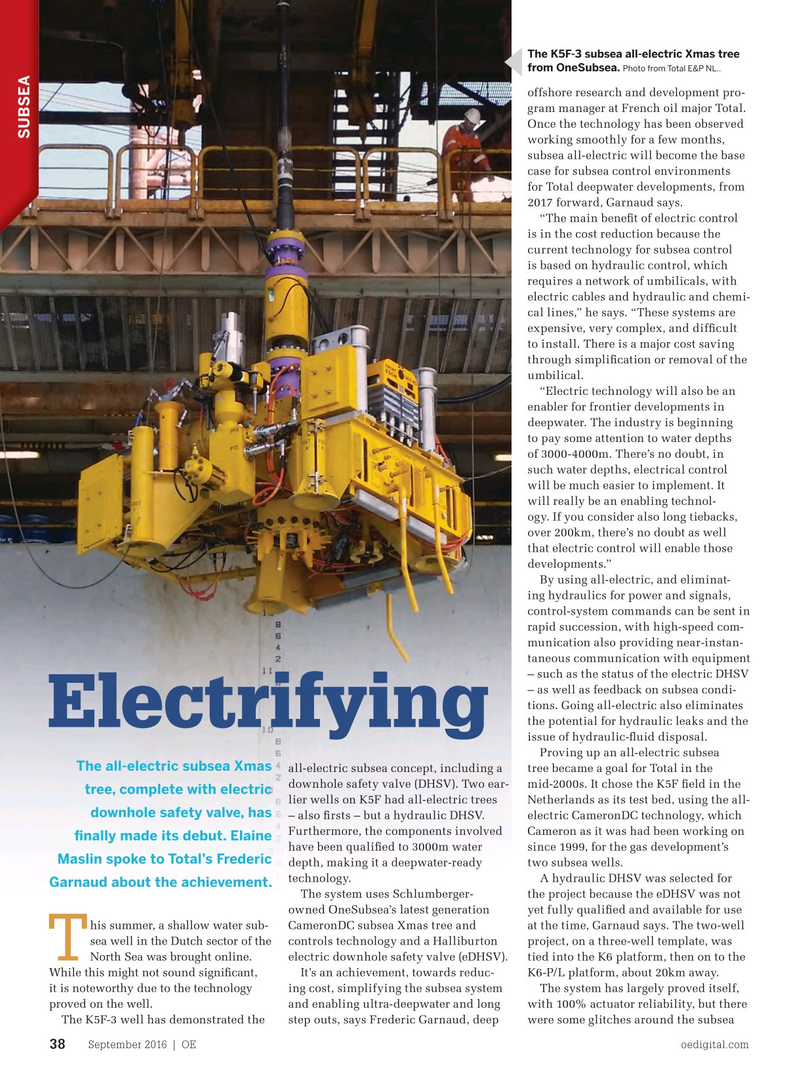
Page 36: of Offshore Engineer Magazine (Sep/Oct 2016)
Read this page in Pdf, Flash or Html5 edition of Sep/Oct 2016 Offshore Engineer Magazine
The K5F-3 subsea all-electric Xmas tree from OneSubsea. Photo from Total E&P NL..
offshore research and development pro- gram manager at French oil major Total.
Once the technology has been observed
SUBSEA working smoothly for a few months, subsea all-electric will become the base case for subsea control environments for Total deepwater developments, from 2017 forward, Garnaud says. “The main bene? t of electric control is in the cost reduction because the current technology for subsea control is based on hydraulic control, which requires a network of umbilicals, with electric cables and hydraulic and chemi- cal lines,” he says. “These systems are expensive, very complex, and dif? cult to install. There is a major cost saving through simpli? cation or removal of the umbilical. “Electric technology will also be an enabler for frontier developments in deepwater. The industry is beginning to pay some attention to water depths of 3000-4000m. There’s no doubt, in such water depths, electrical control will be much easier to implement. It will really be an enabling technol- ogy. If you consider also long tiebacks, over 200km, there’s no doubt as well that electric control will enable those developments.”
By using all-electric, and eliminat- ing hydraulics for power and signals, control-system commands can be sent in rapid succession, with high-speed com- munication also providing near-instan- taneous communication with equipment – such as the status of the electric DHSV – as well as feedback on subsea condi- tions. Going all-electric also eliminates the potential for hydraulic leaks and the
Electrifying issue of hydraulic-? uid disposal.
Proving up an all-electric subsea
The all-electric subsea Xmas all-electric subsea concept, including a tree became a goal for Total in the downhole safety valve (DHSV). Two ear- mid-2000s. It chose the K5F ? eld in the tree, complete with electric lier wells on K5F had all-electric trees Netherlands as its test bed, using the all- downhole safety valve, has – also ? rsts – but a hydraulic DHSV. electric CameronDC technology, which
Furthermore, the components involved Cameron as it was had been working on ? nally made its debut. Elaine have been quali? ed to 3000m water since 1999, for the gas development’s
Maslin spoke to Total’s Frederic depth, making it a deepwater-ready two subsea wells. technology. A hydraulic DHSV was selected for
Garnaud about the achievement.
The system uses Schlumberger- the project because the eDHSV was not owned OneSubsea’s latest generation yet fully quali? ed and available for use his summer, a shallow water sub- CameronDC subsea Xmas tree and at the time, Garnaud says. The two-well sea well in the Dutch sector of the controls technology and a Halliburton project, on a three-well template, was
T
North Sea was brought online. electric downhole safety valve (eDHSV). tied into the K6 platform, then on to the
While this might not sound signi? cant, It’s an achievement, towards reduc- K6-P/L platform, about 20km away. it is noteworthy due to the technology ing cost, simplifying the subsea system The system has largely proved itself, proved on the well. and enabling ultra-deepwater and long with 100% actuator reliability, but there
The K5F-3 well has demonstrated the step outs, says Frederic Garnaud, deep were some glitches around the subsea
September 2016 | OE oedigital.com 38 038_OE0916_Subsea1_K5F.indd 38 8/24/16 1:00 PM

 35
35

 37
37